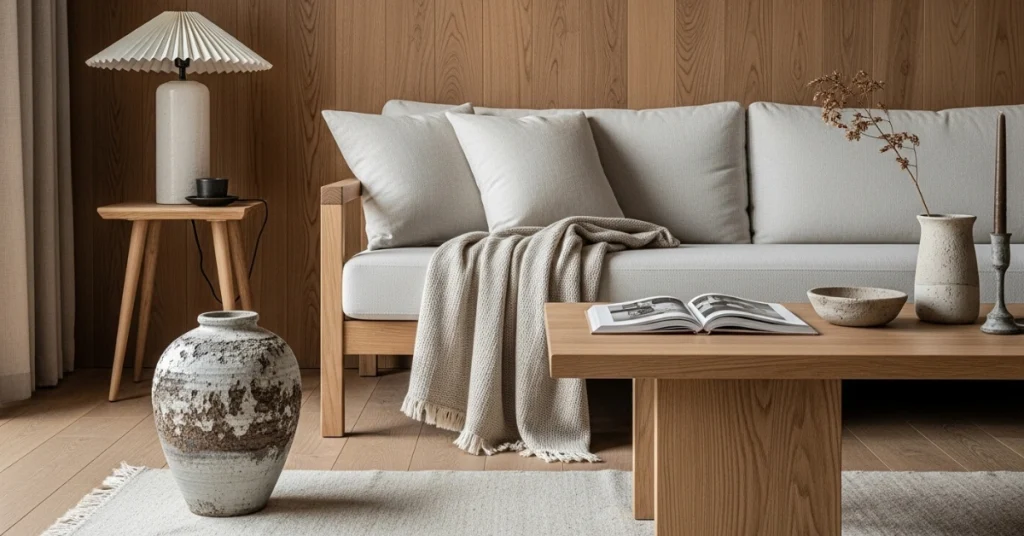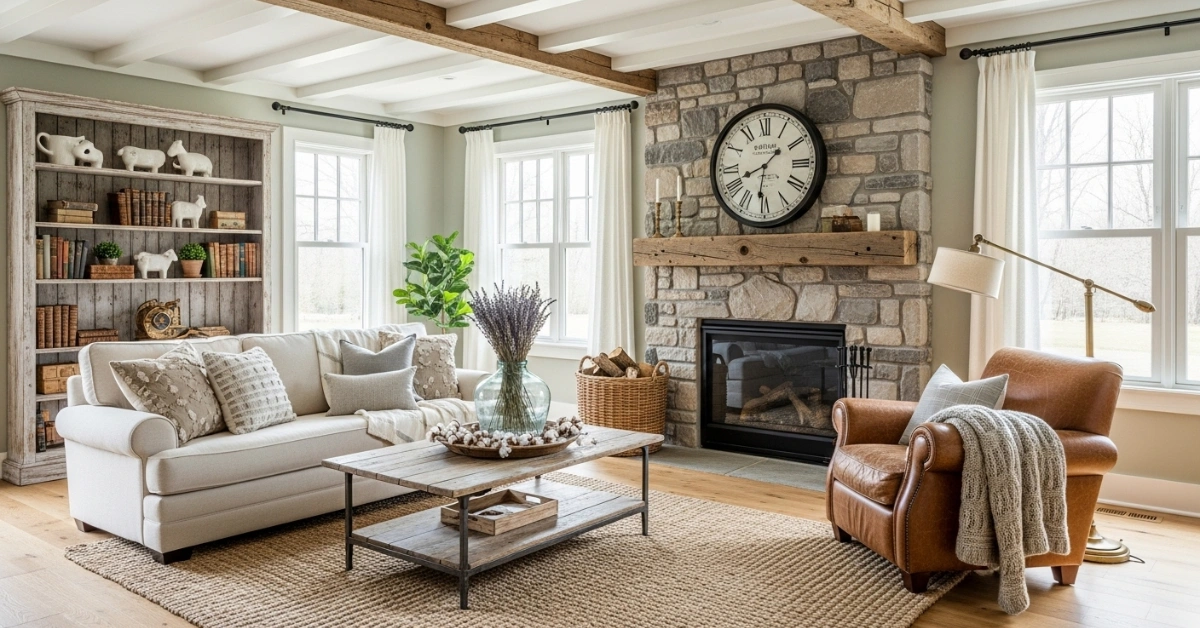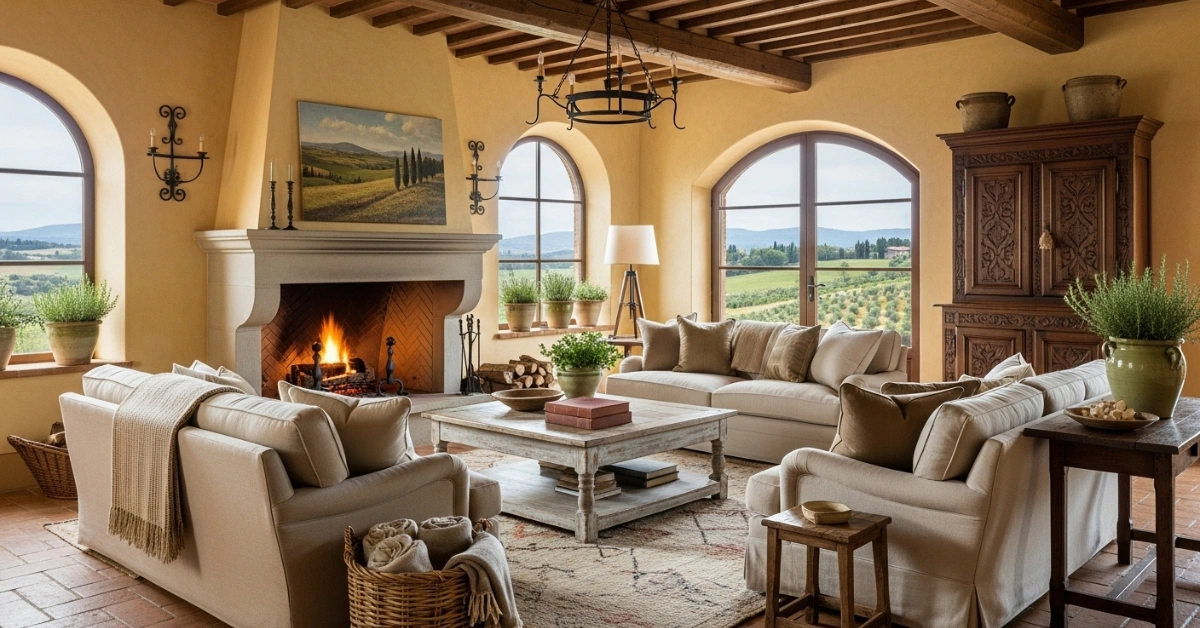12 Japandi Living Room Ideas: Serene Designs

In today’s busy world, living rooms often turn into dumping grounds for daily clutter. Piles of remote controls, scattered magazines, and mismatched decor can make the space feel overwhelming rather than restful. This chaos drains energy, turning what should be a haven into just another source of stress.
That’s where a Japandi living room comes in as a fresh answer. This design approach mixes the clean simplicity of Japanese spaces with the cozy feel of Scandinavian homes, creating a balanced spot that’s both calming and practical. By focusing on what truly matters, a Japandi living room helps you unwind and recharge without the noise of excess stuff.

What Is a Japandi Living Room?
A Japandi living room brings together two distinct yet complementary worlds. It pulls from Japanese traditions of minimalism and respect for nature, while adding the warm, inviting touch of Scandinavian design. The result is a space that feels open, thoughtful, and grounded.
At its heart, this style prioritizes function over form. Every item in the room serves a purpose, whether it’s a low coffee table for gatherings or a simple shelf for a few cherished books. People drawn to Japandi often seek a break from bold trends, opting instead for something enduring and subtle.
This fusion creates rooms that are easy to live in. Natural light floods in, highlighting soft textures and clean lines. It’s not about emptying the space entirely but choosing pieces that enhance daily life without overwhelming it.

The Origins of Japandi Style
Japandi didn’t appear overnight; its roots stretch back over a century. When Japan opened its borders in the mid-1800s after a long period of isolation, Scandinavian designers discovered a shared love for simplicity and craftsmanship. They brought back ideas from Japanese art and architecture, blending them with their own Nordic ways.
This exchange laid the groundwork for what we now call Japandi. Early influences included Japanese ceramics and woodwork, which inspired Danish creators to experiment with natural materials and understated forms. Over time, these elements evolved into a modern hybrid that values both cultures’ emphasis on quality and harmony.
Today, Japandi stands as a bridge between East and West. It’s gained popularity for its ability to adapt to various homes, from city apartments to countryside retreats. Designers continue to refine it, keeping the core ideas alive while making them fit contemporary needs.

Core Principles of Japandi Design
Japandi rests on a few key ideas that guide every choice. First, minimalism rules, keep only what’s needed to avoid visual noise. This creates breathing room, letting the eye rest on thoughtful details.
Functionality pairs with this simplicity. Furniture and decor must work hard, like a bench that doubles as storage or a lamp that adjusts for different moods. Sustainability matters too, with a push toward long-lasting materials that age well.
Wabi-sabi from Japan celebrates imperfection, while hygge from Scandinavia adds coziness. Together, they form spaces that feel lived-in yet polished. “This design style and principles truly supported a healthy meaningful lifestyle. It teaches us to find beauty in imperfection, form deep connections to the earth and nature, and enjoy the simple pleasures of life,” notes designer Shanty Wijaya.

Color Palettes for Your Japandi Living Room
Colors in a Japandi living room stay neutral to promote calm. Think soft whites, warm beiges, and light grays as the base. These shades reflect light, making the room feel larger and more open.
Earthy tones add depth without overpowering. Subtle greens or browns can appear in accents, drawing from nature’s palette. Avoid bright pops; instead, let textures like wood grain provide interest.
For balance, mix light Scandinavian hues with darker Japanese influences. A cream wall might pair with a charcoal throw, creating contrast that’s gentle on the eyes. “The biggest focus is to stay with subtleness. Less is more!” advises interior expert Julee Wray.
This approach keeps the space versatile. It works year-round, adapting to changing light without needing major updates.

Materials and Textures in Japandi Living Rooms
Natural materials define Japandi. Wood takes center stage, often in light oaks or birches for a Scandinavian vibe, or darker walnuts for Japanese depth. Leave it unfinished to show the grain and patina over time.
Fabrics like linen, cotton, and wool add softness. These textiles drape naturally, inviting touch without fuss. Stone or bamboo accents bring in earthiness, grounding the room.
Textures play a big role in adding warmth. A rough ceramic vase contrasts smooth wooden floors, creating subtle variety. Choose items that feel good in hand, reinforcing the style’s focus on comfort.
Sustainability guides selections here. Opt for reclaimed wood or eco-friendly fibers to align with Japandi’s respect for the environment. This not only looks right but feels responsible too.

Furniture Choices for a Japandi Living Room
Furniture in a Japandi living room keeps things low and simple. Low-slung sofas encourage relaxation, echoing Japanese floor seating traditions. Pair them with slim side tables for balance.
Multi-purpose pieces shine here. A coffee table with hidden storage hides remotes and books, maintaining clean surfaces. Benches or ottomans can serve as extra seating or footrests.
Wood frames dominate, but mix tones for interest, like a light oak chair next to a darker teak cabinet. Avoid ornate details; clean lines let the materials speak.
Designer Laila Rietbergen suggests, “Maybe some people think Japandi just happened, but the relationship between Japan and Scandinavia started a long time ago.” Her tip: Start with one standout piece and build around it.
Consider scale too. In smaller rooms, choose compact items to preserve openness. Larger spaces can handle bigger elements, like a modular sofa that adapts to needs.

Lighting Strategies in Japandi Living Rooms
Natural light leads in Japandi design. Large windows or sheer curtains let sunshine pour in, highlighting textures and colors. This connection to the outdoors enhances the serene feel.
For evenings, soft artificial options take over. Paper lanterns or simple pendants provide gentle glows, avoiding harsh overheads. Floor lamps with adjustable arms offer flexibility.
Warm bulbs mimic daylight, keeping the mood cozy. Candles add a hygge touch, their flicker creating intimate corners. “We’re seeing the Japandi style manifest in limewash wall finishes and rich midtone woods to bring a sense of calm and ease to balance people’s everyday living,” shares Danielle DeBoe Harper from Moen.
Layer lights for variety, task for reading, ambient for lounging. This keeps the space functional while maintaining tranquility.

Incorporating Nature into Your Japandi Living Room
Plants are essential in Japandi. A few potted ferns or bonsai trees bring life, echoing both cultures’ love for greenery. Place them on shelves or floors for easy integration.
Natural elements extend beyond plants. Stones as decor or woven baskets add organic touches. These items connect the indoors to the outside world.
Water features, like a small fountain, can introduce soothing sounds. But keep it subtle to avoid clutter. The goal is harmony, not overload.
In one home project I recall, adding a single large ficus transformed a stark room into a breathing oasis. It softened edges and improved air quality, proving small changes yield big results.

Accessories and Decor for Japandi Living Rooms
Accessories stay minimal but meaningful. A handmade ceramic bowl or a woven throw can serve as focal points. Choose items with stories, like artisanal pottery.
Art follows suit,simple prints or abstract pieces in neutral frames. Hang them sparingly to let walls breathe. Avoid galleries; one or two suffice.
Bookshelves display curated collections. Stack books horizontally or vertically for visual interest, mixing in small sculptures.
Heather Hilliard notes, “I think with the shift toward craftsmanship, Japandi design will continue to be a popular style. Incorporating pieces that are handmade with a bit of imperfection gives spaces gravitas and visual interest.” This imperfection adds character without chaos.

Practical Tips for Designing Your Japandi Living Room
Start by assessing your space. Measure dimensions and note natural light sources. This helps plan layouts that flow well.
Declutter ruthlessly. Remove items that don’t spark joy or serve a purpose. Store essentials out of sight.
Build a mood board. Collect images of Japandi living rooms, focusing on colors and materials that appeal. Tools like Pinterest can help visualize.
Budget wisely. Invest in key pieces like sofas, then add affordable accents. Thrift stores often yield vintage finds that fit perfectly.

Step-by-step guide:
- Choose your base color scheme, neutrals first.
- Select anchor furniture, like a sofa and table.
- Add lighting and plants for warmth.
- Incorporate textures through fabrics.
- Refine with a few decor items.
Mark Cravotta advises, “By combining the two, we are elevating Scandinavian design and making Japanese design more accessible.” Test arrangements before committing.
For small spaces, use mirrors to amplify light. In larger ones, zone areas with rugs.
Japandi Living Room Ideas for Small Spaces
Even tiny rooms can embrace Japandi. Opt for wall-mounted shelves to free floor space. Foldable furniture adapts to needs.
Light colors expand the feel. A pale rug underfoot defines the area without closing it in.
In a compact apartment I helped redesign, we used a low platform sofa and hanging plants. It turned a cramped corner into a cozy nook, proving scale matters.
Multi-functional items excel here. A trunk as a coffee table stores blankets inside.

Japandi Living Room Ideas for Large Spaces
Bigger rooms allow for zoning. Create a reading corner with an armchair and lamp, separate from the main seating.
Layer rugs for definition. A large wool one anchors the sofa, while smaller ones mark other spots.
Boldly mix woods, light floors with dark accents. This adds depth without overwhelming.
One spacious home featured a central fireplace flanked by built-in benches. It fostered gatherings while keeping the Japandi calm.

Budget-Friendly Japandi Living Room Transformations
You don’t need a fortune for Japandi. Shop secondhand for wooden pieces; sand and stain them yourself.
DIY elements like linen curtains or potted herbs add charm cheaply. Upcycle old items into decor.
Focus on quality over quantity. A single good lamp beats several cheap ones.
In a low-budget makeover, we painted walls in soft beige and added thrift-store vases. The change was dramatic yet affordable.

Sustainable Practices in Japandi Living Rooms
Sustainability fits Japandi naturally. Choose FSC-certified woods and organic fabrics.
Repurpose items to reduce waste. An old ladder becomes a blanket rack.
Energy-efficient lighting cuts costs and environmental impact.
“Opting for vintage, reclaimed, or handmade items, embracing imperfections, and using eco-friendly, sustainable materials,” recommends Shanty Wijaya.

Common Mistakes to Avoid in Japandi Living Rooms
Don’t overdo minimalism to the point of sterility. Add personal touches for warmth.
Avoid mismatched scales, too many small items clutter, while oversized ones dominate.
Ignoring lighting leads to dim, uninviting spaces. Balance natural and artificial sources.
Keyword stuffing in decor? No, keep it natural. “Reduce clutter with clean lines and open spaces,” suggests Leni Calas.
Forgetting functionality turns beauty into frustration. Ensure every piece works.
Real-Life Japandi Living Room Examples
Picture a living room with lime-washed gray walls and a dark wood coffee table. Scandinavian stools surround it, with a stone fireplace adding hygge.
Another features a low black bedframe in an adjacent space, but for the living area, a gray striped sofa faces large windows, plants framing the view.
In a remodeled home, the owners turned a basic setup into Japandi bliss with oak furniture and neutral rugs. It expanded from cluttered to calm.
A kitchen-living hybrid uses midtone woods and linen accents for seamless flow. Modern art on walls keeps it fresh.
These examples show Japandi’s versatility. From urban lofts to family homes, it adapts while staying true to its roots.

Maintaining Your Japandi Living Room Over Time
Keep the space fresh with regular tidying. Dust surfaces and rotate decor to prevent boredom.
Refresh plants seasonally. Prune and repot as needed for health.
Update fabrics occasionally, new throws or pillows revive the look without major changes.
Embrace patina. Let wood age naturally, enhancing wabi-sabi appeal.
Annual reviews help. Assess what’s working and tweak accordingly.

Conclusion
A Japandi living room offers lasting peace in a hectic world. It combines the best of two traditions for spaces that nurture body and mind. Whether starting fresh or tweaking existing decor, this style delivers simplicity with soul.
By embracing its principles, you create a home that’s not just beautiful but truly livable. The Japandi living room stands as a testament to thoughtful design that endures.
Ready to bring Japandi into your home? Start small with one change, like adding a plant or decluttering a shelf. Share your progress in the comments below, or reach out to a local interior designer for personalized guidance. Your serene space awaits!






